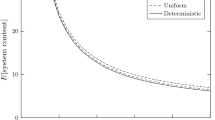Abstract
In this paper we investigate multiserver queueing systems with regenerative input flow and independent service times with finite mean. Various service disciplines are considered: systems with common queue and systems with parallel queues when an arrived customer chooses server in accordance with a certain rule and stays in chosen queue until the moment of service start. We define some classes of disciplines and establish the necessary and sufficient condition of stability.
Similar content being viewed by others
References
J. Grandell, Double Stochastic Poisson Processes, Lecture Notes in Mathematics (Springer, Berlin, Heidelberg, New York, 1976).
S. Asmussen, “Ladder heights and the Markov-modulated M|G|1 queue,” Stochast. Process Appl. 37, 313–326 (1991).
L. Afanasyeva, E. Bashtova, and E. Bulinskaya, “Limit theorems for semi-Markov queues and their applications,” Commun. Stat., Pt. B: Simul. Comput. 41, 688–709 (2012).
S. L. Brunnel, “Some inequalities for parallel-server queues,” Opns. Res. 19, 402–413 (1971).
J. F. C. Kingman, “Inequalities in the theory of queues,” J. R. Stat. Soc., Ser. B 32, 102–110 (1970).
R. W. Wolff, “An upper bound for multi-channel queues,” J. Appl. Prob. 14, 884–888 (1977).
R. D. Foley and D. R. McDonald, “Join the shortest queue: stability and exact asymptotics,” Ann. Appl. Probab. 11, 569–607 (2001).
P. Eschenfeldt and D. Gamarnik, “Join the shortest queue with many servers. The heavy traffic asymptotics,” arXiv:1502.00999.
J. Kiefer and J. Wolfowitz, “On the theory of queues with many servers,” Trans. Am. Math. Soc. 78, 1–18 (1955).
L. G. Afanaseva and A. V. Tkachenko, “Multi-channel queueing systems with regenerative input flow,” Teor. Veroyatn. Primen. 58, 210–234 (2013).
L. G. Afanaseva and E. E. Bashtova, “Coupling method for asymptotic analysis of queues with regenerative input and unreliable server,” Queueing Syst. 76, 125–147 (2014).
A. V. Tkachenko, “Multi-channel queueing systems with non-identical servers,” Dissertation (Moscow, 2013).
R. M. Loynes, “The stability of a queue with non-independent inter-arrival and service times,” Proc. Cambridge Phil. Soc. 58, 494–520 (1962).
W. Whitt, Stochastic-Process Limits: An Introduction to Stochastic-Process Limits and their Application to Queues (Springer, Berlin, 2002).
L. G. Afanaseva, “Ergodicity of multi-channel queueing systems,” in Proceedings of the Workshop on Problems of Stability of Stochastic Models, 1987.
Author information
Authors and Affiliations
Corresponding author
Additional information
Submitted by A. M. Elizarov
Rights and permissions
About this article
Cite this article
Afanasyeva, L.G., Grishunina, S.A. Queueing systems with different service disciplines. Lobachevskii J Math 38, 864–869 (2017). https://doi.org/10.1134/S199508021705002X
Received:
Accepted:
Published:
Issue Date:
DOI: https://doi.org/10.1134/S199508021705002X




